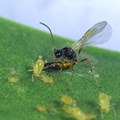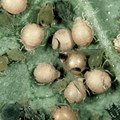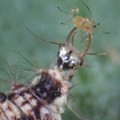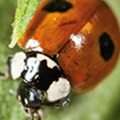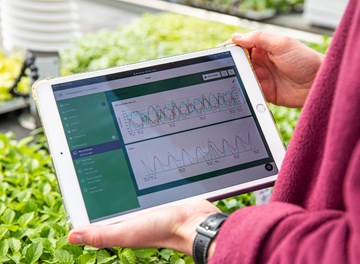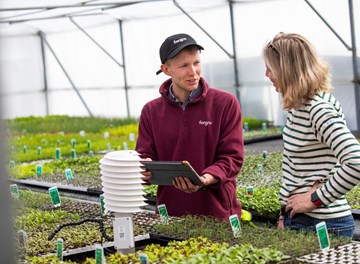
Find out more about our aphid controls
Aphidius colmani - This tiny braconid wasp is particularly effective against round bodied aphid species, such as the melon or cotton aphid (Aphis gossypii), peach aphid (Myzus persicae) and tobacco aphid (Myzus nicotianae).
It is not effective against Macrosiphum species. It can control large populations of aphids, but will take time to achieve this and may leave many parasitised 'mummy' bodies on plants.
Aphidius ervi - specifically for the larger elliptical shaped species including Macrosiphum euphorbiae (potato aphid), and Aulacorthum solani (glasshouse potato aphid).
Several other aphid species such as the pea aphid are also parasitised. A strong flier, it can locate small aphid colonies, making it excellent for preventive applications. Capable of parasitising hundreds of aphids.
Please note that aphidius ervi also features in a number of our parasitoid mixes, click here for more information
Aphelinus abdominalis - Parasitic wasps that control a wide range of aphid species including Macrosiphum euphorbiae (potato aphid) and Aulacorthum solani (glasshouse potato aphid). Aphelline AB also has a side effect against Myzus persicae (peach potato aphid). It has a very long life span.
The parasitised aphid hardens into a leathery black coloured mummy. The adult parasitic wasp emerges through a hole with a jagged edge at the rear of the mummy. The first mummies can be seen in the crop a minimum of 2 weeks after the first introduction
Aphidius matricariae - effective against Myzus persicae nicotianae (tobacco aphid) and Myzus persicae persicae (peach potato aphid) and Ovatus crataegarius (mint aphid). Has a side effect on cotton aphid.
Aphidius colmani, Aphidius ervi and aphelinus abdominalis - By releasing a three-way mixture of aphid parasites, a broad spectrum of aphid pests on different plants is targeted, thus reducing the worry of making an incorrect identification.
These 2-3mm mini-wasps are best used for preventing the establishment of more than 25 different species of aphid including the most common pest species, Aphis gossypii, Macrosiphum euphorbiae and Myzus persicae.
Aphidius colmani, Aphidius ervi - Ideal for ornamental producers and professional nurseries, as well as hobby gardeners. Mix contains 2 parasites (Aphidius colemani and Aphidius ervi) in one pack providing multiple control of all important aphids.
Aphidius colmani, Aphidius ervi, Aphidius matricarae, Aphelinus abdonimalis, Praon volucre - By releasing a three-way mixture of aphid parasites, a broad spectrum of aphid pests on different plants is targeted, thus reducing the worry of making an incorrect identification.
These 2-3mm mini-wasps are best used for preventing the establishment of more than 25 different species of aphid including the most common pest species, Aphis gossypii, Macrosiphum euphorbiae and Myzus persicae.
Aphidius colemani, Aphidius ervi, Aphidius matricariae, Aphelinus abdominalis, Praon volucre and Ephedrus cerasicola.
The mixtures reduce the need for accurate pest species identification and are suitable for preventative use against a range of aphid species, particularly in mixed cropping situations.
Contains equal portions of Aphidius colemani, Aphidius ervi, Aphidius matricariae, Aphelinus abdominalis, Praon volucre and Ephedrus cerasicola.
Mixes reduce the need for accurate pest species identification and are suitable for preventitive use against a range of aphid species, particularly in mixed cropping situations.
Aphidoletes aphidimyza - Introduced as cocoons from which adults emerge. Adults lay eggs next to aphid colonies located by the scent of honeydew, larvae develop as tiny orange maggots that feed on aphids.
Apply between April and September for re-cycling generations, however they can be used all year round if supplementary lighting is available.
Chrysoperla carnea - Young larvae of predatory lacewing. An extremely active predator with large pincers used to attack, hold and suck the juices from the pest body. Effective at controlling established aphid populations.
Also feed on whitefly eggs and scales, thrips larvae, moth eggs, young mealybug and other small insects.
Adalia bipunctata - A species of ladybird native to the UK. The adult beetle and larvae are both predatory. Aphids are the preferred food for ladybirds, and both adults and larvae feed on most types.
